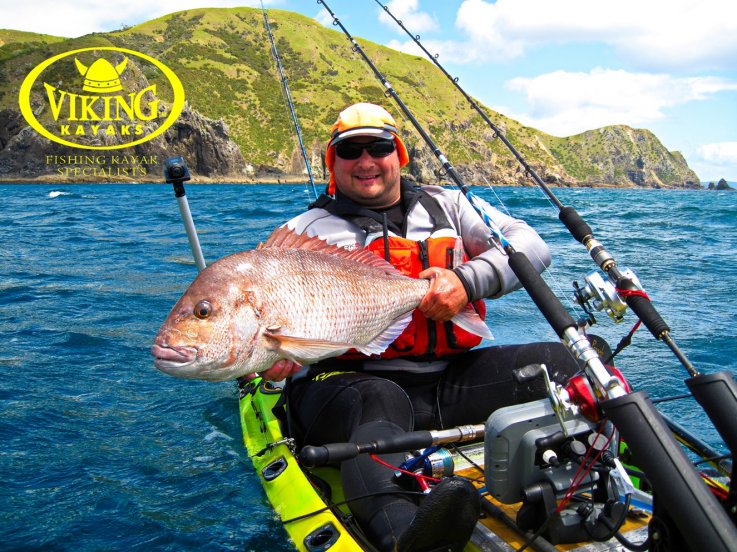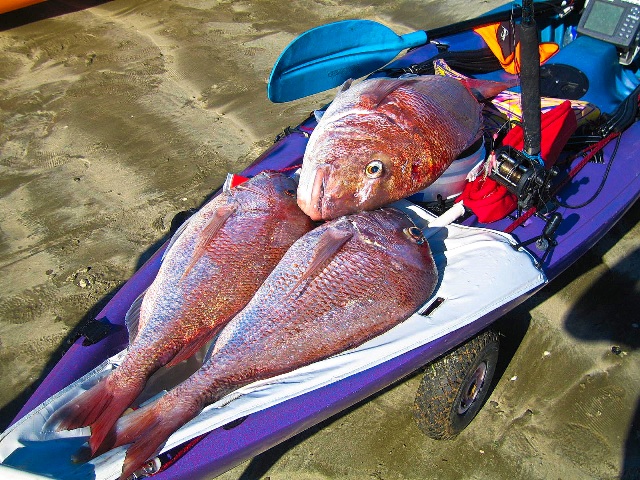Kayak Fishing with Small Frame Reels
5:14PM 2nd Sep 14

(Milkey is another angler who enjoys fishing small but powerful reels, and on a breezy Northland day had no problems skull-dragging this prize from the stones!)
Small frame fishing reels, by Stephen Tapp (written for the August 2014 issue of NZ Fishing News Magazine)
Winter kayak fishing and having awesome fun seems almost a contradiction to the uninitiated. They can’t fathom why any person in their right mind seeks to surround themselves with an ocean of cold water while every little breeze chills unprotected extremities. For those familiar with the sport though, excitement reigns as some of our best fishing happens at this time of year.
It doesn’t matter whether your passion is lurking in close working kelp lines and gutters, or further out plumbing the depths, winter fishing offers something for everyone. Large snapper are easier to target around structure while their smaller brethren take up residence in deeper water. Trophy class trevally can be found in high current areas without having to deal with so many pesky yellow and green rats. Further out there’s the opportunity to supplement terakihi, gurnard, and cod with the odd hapuku if you watch your sounder closely.
(I am now fishing most often with good quality smaller reels designed for braid lines. Comfortable and convenient to use they’re easily up to the task of landing big fish to the kayak)
So given all this potential for encounters with fish that will stretch tackle limits why am I fishing with smaller and smaller reels? This is the question that struck me as I sat down to service my reels in anticipation of the next prospecting trip north (the Cove to Cape kayak fishing competition is creeping up fast). Over the last couple of years all these small reels have been in constant use, while many of the larger models simply get a dust-off instead of a service as they haven’t been anywhere near the water.
Compact Power
Compact reels have come a long way since my 1980’s Millionaire and its drag washers that looked to be made of fine grade leather. This reel gave sterling service casting lures to kahawai from the rocks, but its demise on a hard fighting fish when discovering the big fish potential of kayaks had me move to much larger reels (I hooked a fish that warped the classic post style frame and seized the reel before the line finally parted)
Over the last few years though I’ve been moving back towards smaller sized reels. They’re lighter in weight and their smaller frames make them much more pleasant to use in the close confines of a kayak cockpit. They also fit the hand nicely for better line control, and for those of us transitioning surf on a regular basis they’re considerably easier to stow inside hatches or storage/tackle wells. This makes it possible to remove them from their rods and protect them from sandy drowning’s.
The biggest difference between these modern small frame reels and the classics is that many are designed for high performance braid lines. The high tensile strength and lack of stretch of these fine diameter lines means they place greater loads on spools, drags, bearings, and frames, and the reels have been engineered to cope with this. Simply checking the kinds of drag pressures now achievable gives a good indication of what these reels are capable of.

(Back in the day much of our fishing was done with larger reels to get the reliability and performance to land big fish on kayaks. Braid lines have forced the improvement of smaller reels to the point that this practice is no longer required.)
As a consequence kayak anglers can now fish aggressively with these little reels using any line classes that are practical from kayaks. Further, if properly maintained they’re so smooth to use that even lighter lines will fish as if they’re a class or two heavier (provided your knots are up to the task). The low inertia of lighter spools and mechanics allows them to accelerate more quickly in response to big head thumps or radical changes in line pressure as big fish go ballistic on the hook.
No substitute for quality
I do believe there’s one rule of thumb when it comes to buying small sized kayak fishing reels: purchase as much quality as you can afford. Like any piece of precision mechanics used near salt water, quality design, materials, and construction definitely makes an immense difference to reliability. As a general rule it also makes the reels easier to keep serviced.
This leads into my next suggestion: if you want any of your reels to give good reliability it will pay to properly look after them. This means stripping, cleaning, and properly lubing them on a regular basis, even if a reel only sees occasional use (often it’s the reels used only once or twice a year rather than those used all the time that will cause the most grief).
(Service time: from the writers collection it’s interesting to see which of these reels are in regular use, and those that simply need a dusting before going back into the rack.)
A couple of the reels that have become constant companions on all my kayak fishing sessions are approaching 10 years old, and are perfect examples of the benefit of purchasing quality. Not only are they a joy to use, I also know I can absolutely rely on them. The only down side is that it’s incredibly difficult to justify spending money on new toys!
So why bait casters?
My go-to reels for the bulk of my kayak fishing are now bait casters. I use both the round body style for line classes up to and including 15kg, and the low profile style for classes up to 10kg. The great appeal with both styles is their versatility. With practice they cast well, they’re effective when trolling, and are incredibly useful when bait fishing as they allow you to stay in touch with your hooks without unduly influencing presentation.
Typically I use the round body style when fishing slightly heavier line classes and where I’m targeting bigger fish in deeper water. The greater line capacity of the larger spools means drag pressures don’t increase as much as more line comes off the spool effectively decreasing its diameter. This is possibly the hardest thing for an angler to get their head around when fishing small reels – the need to back the drag off as more line disappears from the spool!
When pushing line classes on small reels this point may seem like a contradiction but it can’t be over emphasized – if you want to avoid a bust-off is situations where lots of line is being stripped from the reel, be prepared to reduce your drag!
The smaller spool of the low profile bait casters does have a big advantage when casting. Since they’re smaller and lighter and aren’t holding as line, the reduced inertia makes them much easier to cast. On a well-balanced rod and with practice it’s possible to lob baits and lures considerable distances, especially down-wind (our most common casting direction when drifting and softbaiting).
More and more kayak anglers are discovering some of the other benefits of these little beauties: the better ability to stay in touch with your bait or lure (as the line rolls off the spool rather than as loose coils coming off an egg-beater) and the accuracy with which casts can be made using your thumb to feather the line and drop your offering straight into the strike zone. These are some of the reasons they’re so popular offshore as casting reels.
(Here’s a classic example of how reels have improved so dramatically, these fish all fell to the Daiwa spin outfit despite their size and the more than 100m depth being fished.)
There’s still a place for the egg-beaters
Despite the benefits listed above I still can’t totally leave behind my spinning reels. In some conditions they make casting un-weighted baits or lures easier, with the obvious example being lobbing into the wind. They can also be more convenient when casting at awkward angles such as when back-casting behind the kayak. This is something I do on a regular basis when fishing two rigs to give baits or lures enough separation.
As with the free spool reels I’ve moved to smaller sizes for the bulk of my fixed spool fishing. Softbaiting with massive grubs and heavy heads has taught me just what some of these reels are capable of, and I now have no qualms lobbing big cut baits on nothing more than a “3000 size” heavy softbait reel. The larger and heavier egg-beaters in my collection have been relegated to livebaiting duties or casting surface lures to kingfish. For the rest of my fishing with
My four –reel arsenal
Building on last month’s article "Long or short rods for kayak fishing" and my list of four rods if limited to just those, here’s my selection of reels:
- A low profile bait caster running 8kg braid on the 2.1m 8-10kg rod as a softbait and casting outfit
- A “3000-size” fixed spool reel with 15kg braid as the heavy softbait outfit and for casting bigger baits around rocks and structure
- A round bodied bait caster running 8kg braid on the shorter 1.67m rod as my preferred stray-line and general fishing rig
- And my token heavy rig just in cast – a 24kg jig set that could be either fixed or free spool for everything from mechanical jigging and livebaiting to plumbing the depths.








